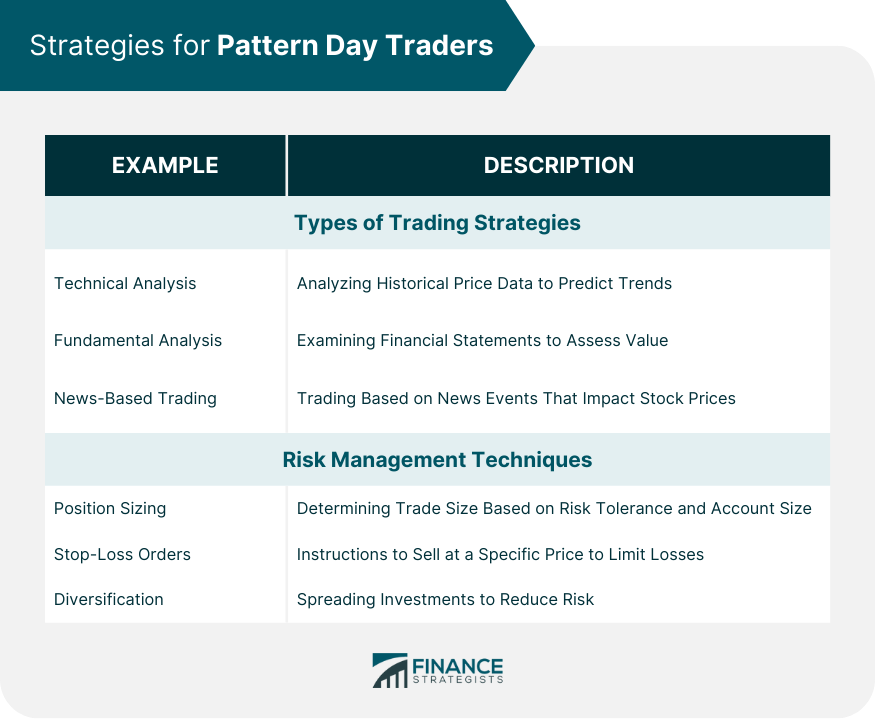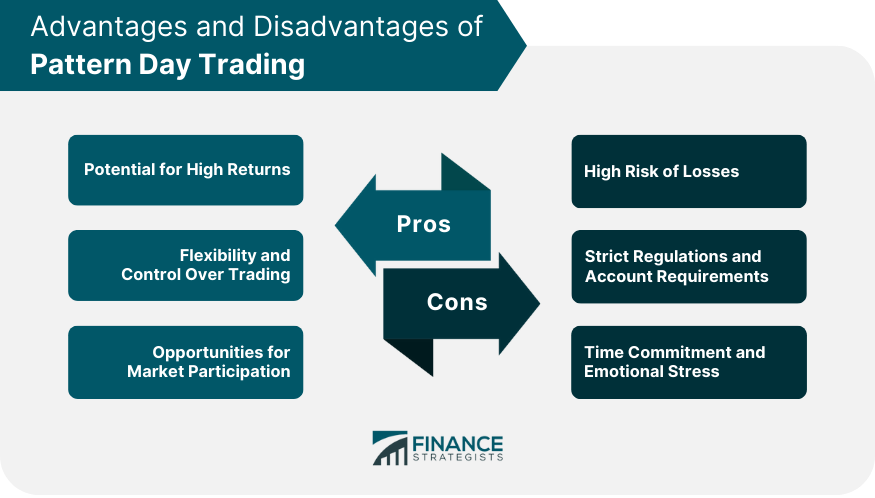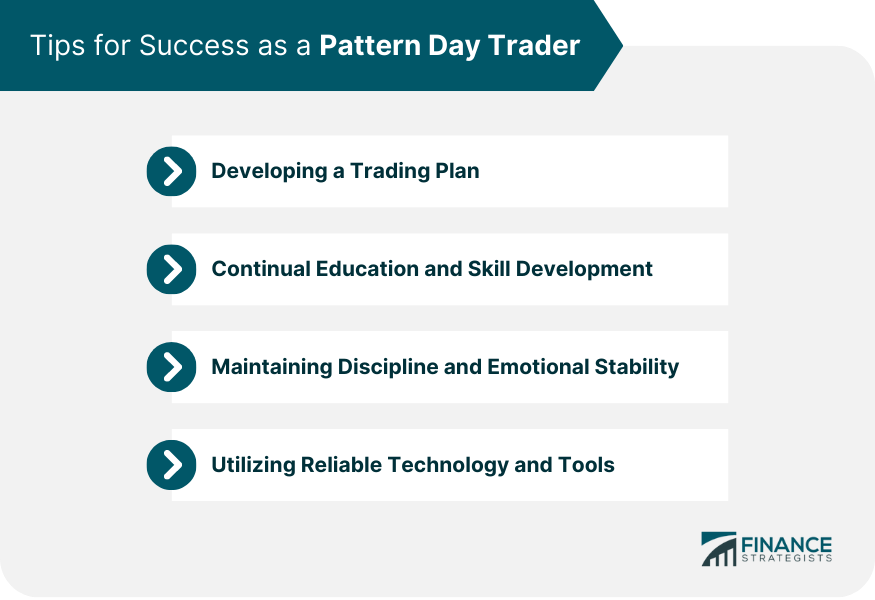A pattern day trader is an individual who engages in the buying and selling of a security, such as stocks, options, or futures, on the same day four or more times in five business days. This trading activity must account for more than 6% of the trader's total trades in the margin account for the same period. Pattern day trading is a high-risk, high-reward activity. It presents opportunities for skilled individuals to reap significant returns on investment. However, because of the potential financial risks involved, regulatory authorities have established stringent rules governing this activity. The SEC oversees the operation of U.S. stock exchanges, and as part of their role, they regulate the activities of pattern day traders. The SEC requires that these traders maintain a minimum account balance and restricts them from making certain types of trades. FINRA is another body that governs pattern day trading. According to FINRA rules, a pattern day trader must keep a minimum of $25,000 in their brokerage account. If a trader's account balance falls below this minimum, they may not be able to trade until additional funds are deposited. A pattern day trader's account must maintain a balance of at least $25,000. This amount includes both cash and securities. A pattern day trader is designated based on the number of day trades made within a rolling five-business-day period. If you execute four or more day trades within this time frame, and these trades account for more than 6% of your total trades, you will be identified as a pattern day trader. Pattern day traders are typically required to have a margin account, which allows them to borrow money to make trades. However, the SEC imposes certain restrictions on these accounts, such as limiting the amount of money that can be borrowed. Brokerage firms monitor trading activity and use specific criteria to identify pattern day traders. These criteria include the number of day trades made and the percentage of day trades relative to total trading activity. Once identified as a pattern day trader, certain trading restrictions apply. For instance, you're limited in the number of trades you can execute unless you maintain the minimum account balance. Pattern day traders are subject to margin call requirements. If your account balance drops below the minimum, a margin call will be issued, and you'll need to deposit more funds into your account. If you fail to meet margin call requirements, your account may be suspended, and you could be prohibited from making further trades for up to 90 days or until your account balance is restored. This strategy involves studying charts and patterns to predict future price movements. Traders use indicators such as moving averages, trend lines, and oscillators to make trading decisions. Fundamental analysis involves evaluating a company's financial health, industry position, and market conditions to determine its potential for growth. This approach involves trading based on news events that could influence the price of a security. It requires keeping up with current events and understanding how they can affect market conditions. This technique involves determining the number of shares to buy or sell based on your risk tolerance and the amount of money you are willing to risk on each trade. Stop-loss orders are a tool for managing risk. By setting a stop-loss order, you can limit your loss by specifying a price at which your security will be automatically sold if its price drops to that level. Diversification involves spreading your investments across various securities to reduce risk. While it's more often associated with long-term investing, day traders can also use this strategy to some degree. Day trading involves constant decision-making, which can lead to high levels of stress and burnout. This stress can be exacerbated by volatile market conditions and the pressure to make quick decisions. Success in day trading can sometimes lead to overconfidence, which in turn can lead to overtrading. Overtrading refers to making excessive trades, which can increase risk and erode trading profits. Day trading requires fast, reliable technology. Traders need a reliable computer and a fast internet connection, as well as access to real-time market data and a variety of trading tools. Day traders must constantly monitor market conditions and news events that might impact their trading. This constant need for vigilance can be both time-consuming and mentally exhausting. Day trading offers the potential for high returns, especially for those who are skilled at navigating the markets. As a day trader, you have the flexibility to trade on your schedule and have complete control over your trading decisions and strategies. Day trading allows you to participate actively in the market, providing opportunities to profit from short-term price fluctuations. Day trading involves significant risk, and traders can lose a substantial amount of money, particularly if they do not adhere to a solid trading strategy. Day traders are subject to strict regulations and high account balance requirements, making this form of trading inaccessible to some. Day trading requires a significant time commitment and can lead to high levels of emotional stress. A trading plan outlines your financial goals, risk tolerance, and specific strategies for entering and exiting trades. It can provide a roadmap to guide your trading decisions. Successful day trading requires continual learning and skill development. This includes staying updated on market trends, learning new trading strategies, and refining your existing skills. Emotional discipline is crucial in day trading. Traders must be able to manage their emotions, stay patient, and stick to their trading plan. Successful day trading requires reliable technology and trading tools. Traders need access to real-time market data, analytical tools, and a stable internet connection. Swing trading is a strategy that involves holding positions for several days to weeks. This approach offers a slower pace than day trading and can be less stressful. Long-term investing involves buying and holding securities for several years. This strategy is based on the belief that in the long run, the markets will deliver a positive return. Passive investing involves buying and holding a portfolio that mirrors a market index. This approach requires less time than active trading and often has lower fees. A pattern day trader is an individual who engages in buying and selling securities on the same day four or more times within a five-business-day period, with these trades accounting for more than 6% of their total trades. While pattern day trading presents opportunities for significant returns, it is a high-risk activity that is subject to strict regulations and account requirements. Traders must maintain a minimum account balance of $25,000 and are restricted in the types of trades they can make. Failure to comply with these regulations can result in trading restrictions, margin call requirements, and even account suspension. Successful pattern day traders employ various trading strategies, such as technical analysis, fundamental analysis, and news-based trading, while implementing risk management techniques like position sizing, stop-loss orders, and diversification. In addition to the potential advantages of high returns, flexibility, and market participation, pattern day trading comes with its share of disadvantages. The risk of losses is high, and traders need to adhere to a solid trading strategy to mitigate this risk. Furthermore, the strict regulations and account requirements make pattern day trading inaccessible to some individuals. It is a time-consuming activity that demands constant vigilance and can lead to significant emotional stress. To succeed as a pattern day trader, it is essential to develop a trading plan, continually educate oneself, maintain discipline and emotional stability, and utilize reliable technology and tools. Alternatively, individuals may consider swing trading, long-term investing, or passive investment strategies like index funds and ETFs as alternatives to pattern day trading. These alternatives offer different approaches with potentially lower stress levels and time commitments. To navigate this complex landscape, it is recommended to seek professional advice from financial advisors or brokers who can provide personalized guidance and help develop a solid trading plan tailored to individual goals and risk tolerance.What Is a Pattern Day Trader?
Pattern Day Trader Rules
Securities and Exchange Commission (SEC) Regulations
Financial Industry Regulatory Authority (FINRA) Rules
Requirements for Pattern Day Traders
Minimum Equity Requirement
Number of Day Trades in a Rolling Five-Day Period
Margin Account Restrictions
Pattern Day Trader Designation
How Brokerage Firms Identify Pattern Day Traders
Consequences of Being Designated a Pattern Day Trader
Restrictions on Trading Activity
Margin Call Requirements
Potential Account Suspension
Strategies for Pattern Day Traders
Types of Trading Strategies
Technical Analysis
Fundamental Analysis
News-Based Trading
Risk Management Techniques
Position Sizing
Stop-Loss Orders
Diversification

Common Challenges Faced by Pattern Day Traders
Psychological Challenges
Stress and Burnout
Overconfidence and the Risk of Overtrading
Practical Challenges
Technology Requirements
Keeping up With Market Conditions
Advantages and Disadvantages of Pattern Day Trading
Advantages
Potential for High Returns
Flexibility and Control Over Trading
Opportunities for Market Participation
Disadvantages
High Risk of Losses
Strict Regulations and Account Requirements
Time Commitment and Emotional Stress

Tips for Success as a Pattern Day Trader
Developing a Trading Plan
Continual Education and Skill Development
Maintaining Discipline and Emotional Stability
Utilizing Reliable Technology and Tools

Alternatives to Pattern Day Trading
Swing Trading
Long-Term Investing
Passive Investment Strategies, Such as Index Funds and ETFs
Final Thoughts
Pattern Day Trader FAQs
A pattern day trader must maintain a minimum equity of $25,000 in their brokerage account.
Pattern day traders are subject to certain trading restrictions and margin call requirements. Failure to meet these can result in account suspension.
Some common strategies include technical analysis, fundamental analysis, and news-based trading.
Alternatives include swing trading, long-term investing, and passive investment strategies.
Developing a trading plan, continual education and skill development, maintaining emotional stability, and utilizing reliable technology and tools are essential for success in pattern day trading.
True Tamplin is a published author, public speaker, CEO of UpDigital, and founder of Finance Strategists.
True is a Certified Educator in Personal Finance (CEPF®), author of The Handy Financial Ratios Guide, a member of the Society for Advancing Business Editing and Writing, contributes to his financial education site, Finance Strategists, and has spoken to various financial communities such as the CFA Institute, as well as university students like his Alma mater, Biola University, where he received a bachelor of science in business and data analytics.
To learn more about True, visit his personal website or view his author profiles on Amazon, Nasdaq and Forbes.











